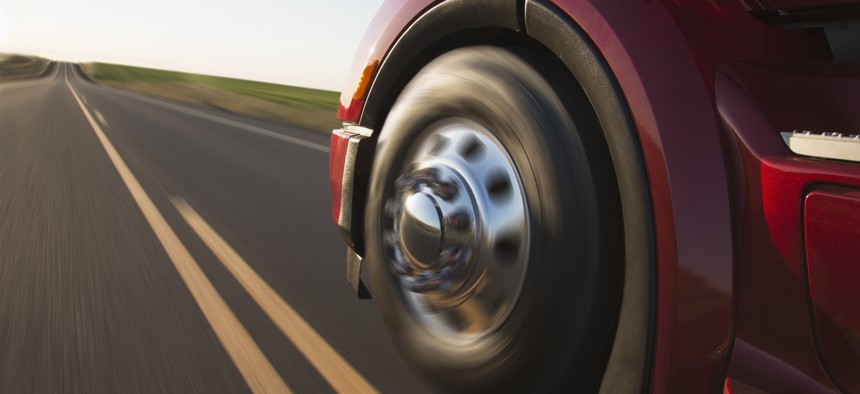States Use Road Sensors to Combat Treacherous ‘Tire Carcasses’

iStock.com/ Jetta Productions Inc
A growing number of states are hoping to use sensor technology embedded in the pavement to fight climate change, keep traffic flowing and save lives.
This story was originally posted by Stateline, an initiative of the Pew Charitable Trusts.
A growing number of states are hoping to use sensors embedded in the pavement to fight climate change, keep traffic flowing and save lives.
Michigan and Indiana are testing systems that would charge electric vehicles while they’re being driven. Some state transportation departments want to use road-based sensors to alert drivers of upcoming detours and closures or to detect crashes and automatically notify emergency responders.
One increasingly popular use for pavement sensor technology takes aim at a significant threat to driver safety: unsafe truck tires, which can suffer blowouts at high speeds that result in serious injuries or deaths.
When a truck crosses the border from Minnesota into South Dakota on Interstate 90, for example, inspectors at the weigh station in South Dakota already know from sensors embedded in the pavement whether the truck has flat, underinflated or mismatched tires that could make it a danger on the road.
“This technology gives you a footprint of every tire,” said Dave Huft, a program manager at the South Dakota Department of Transportation. “If tires are flat or really low, the truck won’t be allowed to continue down the road unless the driver gets them repaired or replaced.”
More than 5,000 people died in large truck crashes in 2019, and nearly 160,000 people were injured, according to the National Highway Traffic Safety Administration. Nearly three-quarters were occupants of other vehicles.
Nearly 360 people died in crashes from 2015 through 2019 involving large trucks that had a tire blowout or flat or a tire-related defect, the federal transportation safety agency’s data shows.
In September, a semitruck’s tire blew out on Interstate 10 near San Antonio, Texas, causing the driver to lose control and the truck to crash through a guardrail, slide down an embankment and catch fire. The driver was critically injured, and his 40-year-old passenger died at the scene.
Highway safety experts say that if a truck tire is underinflated, it can build up heat and disassemble, leaving pieces of the tread—dubbed road gators or tire carcasses—strewn along the highway. That debris can be hazardous to other vehicles.
Federal rules require commercial drivers to inspect their vehicle, including the tires, to ensure it is in safe operating condition before they drive it, and document that inspection at the end of that day.
But that doesn’t mean every truck driver does it or can spot a problem. And sometimes, drivers can have a blowout and not even realize it.
Robert Braswell, executive director of the American Trucking Association’s Technology and Maintenance Council, said carriers need to be proactive. Some, for example, install technology on trucks that continuously monitors and adjusts tire pressure while on the road.
But it’s also a good idea for states to use road sensors near weigh stations, he added. “It can prevent a lot of problems.”
Some states, including South Dakota, also are placing an infrared camera at the weigh station off-ramp. It takes a heat picture of a truck’s brakes and wheels to make sure they’re neither too hot nor too cold. If they are, inspectors will examine them.
Donna Bergan, a spokesperson for International Road Dynamics, Inc., a Canadian-based company that makes the tire sensor system installed in South Dakota, said that about half of states now either use or by the year’s end will be using that system.
State officials say they’re seeing results.
In Virginia, about 25,000 unsafe truck tires have been removed since June 2020, when the state started using the system at a weigh station on I-81 near Winchester, said Jessica Cowardin, a spokesperson for the state Department of Motor Vehicles.
This year, the department, which paid $82,000 for the first sensor system, plans to install another one at another weigh station on I-81 and one on I-85.
“It’s a small price for safety,” Cowardin said.
In Nebraska, where the transportation department owns the weigh stations but state police operate them, troopers are identifying more than 100 flat truck tires a month at the two sites on Interstate 80 that use road sensors, said Nebraska State Patrol Lt. Mike Maytum. Previously, they were identifying fewer than five a month.
“Before this, our identification of flat tires relied on officers visually being able to see during a cursory check that there was a low tire,” Maytum said. “That’s an imperfect science.”
Maytum said the road sensor screening is done at highway speed about a mile from the weigh station, allowing the majority of drivers to continue on with their freight “at a time when America really needs that to happen.”
But if the sensors spot a problem, drivers must exit, and officers at the weigh station, who also do enforcement checks that include vehicle registration and driver licensing, examine the tires.
South Dakota also uses the road sensors to detect tire anomalies at highway speed before a truck reaches the weigh station.
Huft said his state started using the road sensor and thermal brake inspection systems at the I-90 weigh station in June 2020. Since then, it has installed both near weigh stations on Interstate 29 at the Iowa and North Dakota borders. Like other states, including Nebraska, it plans to put more of the sensors at other locations.
Nebraska’s Maytum said the systems not only can make highways safer and reduce the amount of work for transportation staffers who pick up highway debris but also can help the trucking industry.
“We’re in the world of supply chain problems,” he said. “As much as we can, we want to get those trucks moving so they can get where they want to go.”
Jenni Bergal is a staff writer at Stateline.
NEXT STORY: It Turns Out State Lawmakers Hate Auto-Renew Contracts, Too





